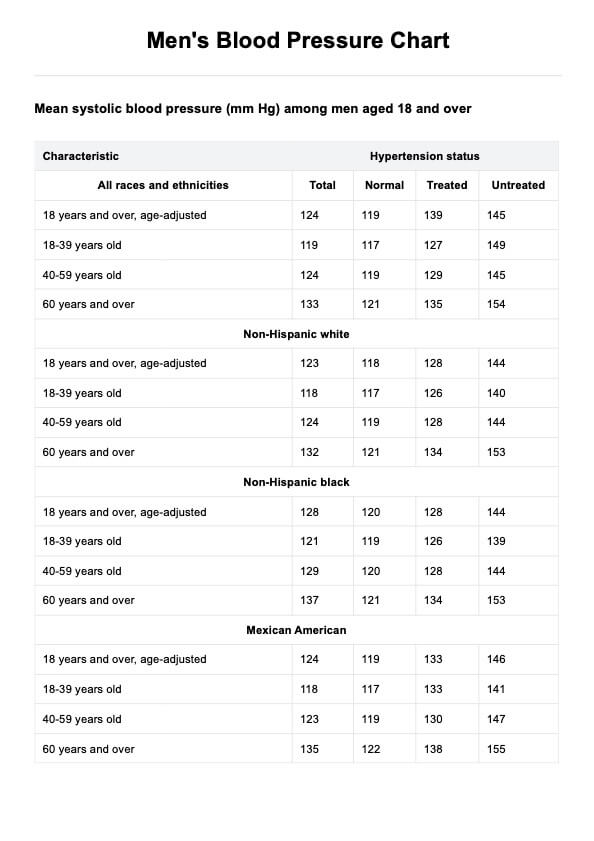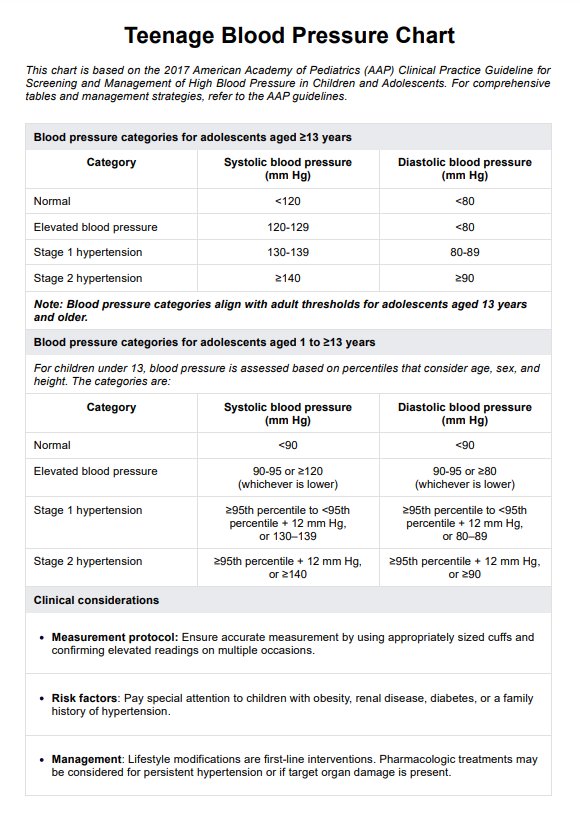Men's Blood Pressure
Track men's blood pressure levels easily with this Men's Blood Pressure Chart. Monitor and guide patients toward healthier cardiovascular health.


What is a Men's Blood Pressure Chart?
A Men's Blood Pressure Chart is a reference tool used to categorize and monitor blood pressure readings specifically for men. The chart typically includes two key measurements: systolic pressure (the pressure in arteries when the heart beats) and diastolic pressure (the pressure between beats).
The male blood pressure chart can vary slightly depending on factors like age, making it useful to consult a blood pressure by age reference. For instance, blood pressure readings can naturally increase with age, so understanding how values change is important for monitoring health. A BP chart for men helps identify if someone falls within the ideal range or is at risk of high blood pressure (hypertension).
To accurately track blood pressure, healthcare professionals should use a reliable blood pressure monitor and compare their patients' results to the blood pressure chart for men. This allows healthcare practitioners and individuals to assess cardiovascular health and take necessary actions to manage blood pressure effectively.
Men's Blood Pressure Template
Men's Blood Pressure Example
Systolic vs. Diastolic blood pressure
Systolic and diastolic blood pressure are the two key components of a blood pressure reading. Systolic pressure refers to the force exerted on the walls of the blood vessels when the heart beats and pumps blood, while diastolic measures the pressure in the arteries when the heart is at rest between beats. A normal range for systolic blood pressure is typically around 120 mmHg, while diastolic pressure falls around 80 mmHg. Both numbers are important, as they indicate how efficiently the heart is pumping and the condition of the arteries.
To measure blood pressure with a blood pressure cuff, factors like age and gender can affect readings, and healthcare professionals often refer to blood pressure by age to assess risks. For men, the ideal blood pressure is usually 120/80 mmHg, but this can increase with age. Blood pressure over 130/80 mmHg is considered high blood pressure and may require interventions such as lifestyle changes or blood pressure medications to lower blood pressure. Consistent high readings increase the risk of damaging the arteries and reducing efficient blood flow, leading to cardiovascular complications. Understanding both systolic and diastolic pressures is crucial in managing overall heart health.
How to use the Men's Blood Pressure Chart?
Carepatron’s Men's Blood Pressure Chart is a practical tool designed for healthcare professionals to track and manage patients’ blood pressure. This guide will walk you through how to effectively use the chart, from accessing the template to incorporating it into patient care.
Access the chart template
Healthcare practitioners can easily find the Men’s Blood Pressure Chart template within this guide. Simply download or access the chart via Carepatron’s platform for convenient use during consultations. Having a digital or printed version readily available ensures you can reference and use it as needed during appointments.
Review the chart content
Before introducing the chart to patients, it’s crucial to review its content. Understanding how the chart displays systolic and diastolic pressures ensures you can provide accurate, informed guidance to your patients.
Introduce the chart to patient
When discussing blood pressure results with your patient, introduce them to the male blood pressure chart. Explain how their current blood pressure readings compare to the ranges on the chart, focusing on specific terms like normal blood pressure and high blood pressure. This helps them visualize and understand their health status.
Use the chart to monitor patient’s condition
Regularly use the BP chart for men to monitor your patient’s condition over time. Encourage them to check their blood pressure at home using a blood pressure monitor, and compare results with the chart to track any changes. This can guide treatment decisions and help prevent complications associated with high blood pressure.
When do medical professionals use this chart?
The Men's Blood Pressure Chart is a vital tool for healthcare professionals, helping them assess and manage their patients’ cardiovascular health. This chart provides a clear breakdown of blood pressure readings, assisting in diagnosis, treatment planning, and monitoring over time. Here are key instances when medical professionals utilize this chart.
During routine health assessments
Medical professionals use the chart during routine checkups to assess a patient's systolic blood pressure and diastolic blood pressure. By comparing these blood pressure numbers to the normal blood pressure range, they can detect potential issues like elevated blood pressure or low blood pressure early on.
When identifying risk factors
If a patient exhibits risk factors such as obesity, smoking, or a family history of cardiovascular disease, healthcare providers use the chart to track blood pressure measures. This helps determine if patients are at risk of developing conditions like high blood pressure or even a hypertensive crisis, which can lead to serious health complications if left untreated.
Monitoring patients with elevated or high blood pressure
For patients diagnosed with elevated blood pressure or untreated high blood pressure, the chart becomes a tool for ongoing monitoring. Regularly checking their blood pressure readings allows practitioners to track progress and adjust treatments as needed to prevent damage to blood vessels and other organs.
Managing hypertensive crises
In cases of hypertensive crisis, where blood pressure numbers spike to dangerous levels, medical professionals use the chart to gauge the severity of the situation. Immediate action is taken to prevent complications, including strokes or heart attacks, linked to high blood pressure.
Commonly asked questions
The new normal blood pressure for seniors is generally considered to be below 120/80 mmHg, though slightly higher readings are common as people age. Blood pressure of up to 130/80 mmHg is often still acceptable for older adults, depending on their overall health.
A reading of 140/70 mmHg may indicate elevated systolic blood pressure, which could signal the onset of hypertension, even though the diastolic number is normal. It’s important to monitor this and consult a healthcare provider to assess overall cardiovascular risk.
A blood pressure of 130/90 mmHg is considered borderline high, with elevated systolic and slightly high diastolic pressure. This indicates stage 1 hypertension and may require lifestyle changes or medical intervention.
For men, a normal blood pressure reading is typically around 120/80 mmHg. This range represents healthy systolic and diastolic pressures, with values above this indicating possible risks for hypertension.
















































































































